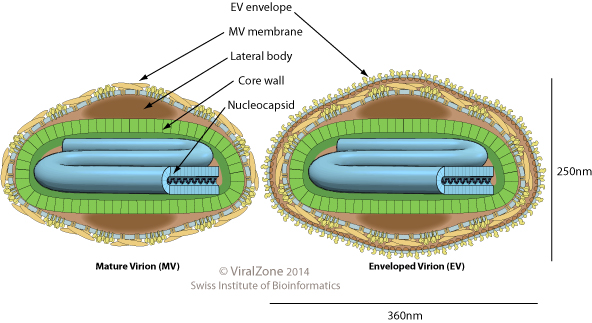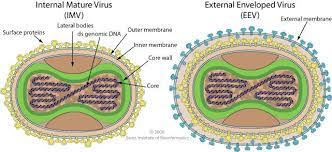Poxviridae is a family of viruses. Humans, vertebrates, and arthropods serve as natural hosts. There are currently 83 species in this family, divided among 22 genera, which are divided into two subfamilies. Diseases associated with this family include smallpox.
Four genera of poxviruses may infect humans: orthopoxvirus, parapoxvirus, yatapoxvirus, molluscipoxvirus. Orthopox: smallpox virus (variola), vaccinia virus, cowpox virus, monkeypox virus, rabbitpox virus; Parapox: orf virus, pseudocowpox, bovine papular stomatitis virus; Yatapox: tanapox virus, yaba monkey tumor virus; Molluscipox: molluscum contagiosum virus (MCV)

Replication of the poxvirus involves several stages.
The virus first binds to a receptor on the host cell surface; the receptors for the poxvirus are thought to be glycosaminoglycans.
After binding to the receptor, the virus enters the cell where it uncoats. Uncoating of the virus is a two step process:
- firstly the outer membrane is removed as the particle enters the cell;
- secondly the virus particle (without the outer membrane) fuses with the cellular membrane to release the core into the cytoplasm.

The pox viral genes are expressed in two phases. The early genes encode the non-structural protein, including proteins necessary for replication of the viral genome, and are expressed before the genome is replicated. The late genes are expressed after the genome has been replicated and encode the structural proteins to make the virus particle.
The assembly of the virus particle occurs in five stages of maturation that lead to the final exocytosis of the new enveloped virion. After the genome has been replicated, the immature virion assembles the A5 protein to create the intracellular mature virion. The protein aligns and the brick-shaped envelope of the intracellular enveloped virion. These particles are then fused to the cell plasma to form the cell-associated enveloped virion, which encounters the microtubules and prepares to exit the cell as an extracellular enveloped virion.


Considering the fact that this virus is large and complex, replication is relatively quick taking approximately 12 hours until the host cell dies by the release of viruses.